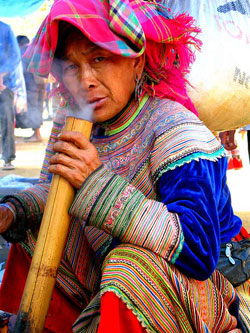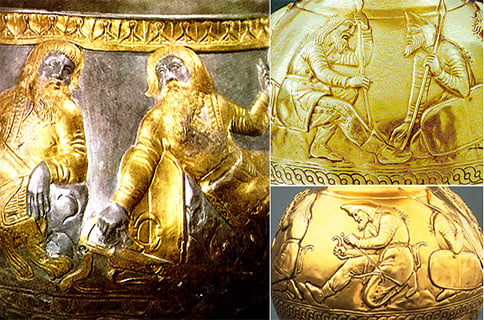The History of the Bong: From Ancient Roots to Modern North America

The bong, one of the most iconic and loved smoking devices, holds a big region inside the records of hashish consumption.
Over centuries, this particular device has evolved, adapted, and unfolded throughout numerous regions, including to the wealthy cultural importance we accomplish with it today.
In this article, we can take you via the captivating records of bongs throughout extraordinary components of the world, from Southeast Asia to Africa, Russia, and North America.
Let`s dive into the origins, developments, and cultural adventures of the bong.
Bong Roots in Southeast Asia
The word "bong" is thought to have originated from the Thai word "buang," which dates back to the 14th century.
"Buang" mentioned a bamboo smoking tool that became used to inhale smoke, and over time, as water became integrated into the design, the time period advanced into "bong," which now refers to a water pipe.
Water pipes had been an essential part of smoking practices in Southeast Asia for centuries.
Traditionally crafted from bamboo or different herbal materials, those gadgets allowed the consumer to inhale the smoke thru water, which helped clear out out and funky the smoke, making the revel in smoother.
Bongs in Central Asia and the Silk Road

The exercise of the usage of water pipes, or bongs, unfolds from Southeast Asia to Central Asia.
The first written information on bong utilization comes from the sixteenth century, especially from the location of Central Asia.
The Silk Road, the historical exchange path connecting China, Central Asia, and the Middle East, performed a pivotal role in the unfolding of hashish and its intake methods.
It is thought that the exercise of the usage of water in smoking gadgets turned into delivered all through the Ming Dynasty in China (1368–1644).
This coincided with the developing recognition of tobacco alongside the Silk Road, which could have been exchanged among investors and explorers.
The exercise became firmly embedded in Chinese tradition all through the Qing Dynasty (1644–1911), with a number of China`s most brilliant figures, including Empress Dowager Cixi, being related to bongs. According to reports, she became so keen on her bongs that she turned into burying them with a number of her most prized pieces, which might nevertheless be on show in the Palace Museum.
Early African Bongs: The World's Oldest Smoking Devices

The Oldest Known Bong-like Devices
In the Ethiopian caves, archaeologists determined the world`s oldest acknowledged bong-like gadgets, dating back to between 1100 and 1400 AD.
These superb discoveries, which covered eleven hand-held bongs crafted from reused pottery and animal horns, are believed to be the oldest examples of smoking gadgets in records.
These bongs had been rudimentary but ingeniously constructed.
They worried about burning coal in a jar that turned into buried within the ground, with hashish positioned on top.
The smoke might then journey via an underground duct to a mouthpiece placed a quick distance away, permitting the consumer to inhale the hashish smoke.
This progressive layout no longer simplest highlights early creativity in smoking accent production but additionally underscores the historical use of hashish for its psychoactive effects.
Preceding the Scythians of Russia
This Ethiopian discovery predates the well-known Scythian bongs observed in Russia, which had been unearthed a good deal later, and similarly demonstrates the lengthy records of water pipe use throughout special continents.
The improvement of such gadgets throughout Africa and Asia indicates that the bong`s simple standards of use had been a fundamental part of human subculture for centuries.
Early Russian Bongs: A Glimpse into Scythian Culture

The Discovery of Golden Bongs in Russia
In 2015, creation people in Russia stumbled upon a kurgan, a burial mound courting lower back approximately 2,400 years, close to the Russian steppe.
The kurgan contained a treasure trove of gold artifacts, together with a couple of fantastically crafted golden bongs, believed to have belonged to the Scythians, a nomadic folks that dominated widespread stretches of Eurasia.
The discovery of hashish and opium residues within the bongs presents bodily proof of drug use a few of the Scythians.
The Greek historian Herodotus had formerly written approximately the Scythians` use of hashish, describing their notion that the herb had magical powers.
These golden bongs possibly performed a function in ceremonial rituals, probably utilized by warriors earlier than avoiding battle.
This discovery increases the question: Did the Scythians invent the water pipe, or did they create the idea lower back from their travels throughout Asia?
Either way, it's miles clean that bongs held wonderful cultural importance in Scythian society, no matter their loss of grand monuments or cities.
The Evolution of the Bong: From Ancient Origins to Modern North American Culture
The Bong`s Journey to North America
The word "bong" first seemed in English within the 1944 Thai-English Dictionary via means of George Bradley McFarland, wherein it changed into described as a bamboo water pipe.
It`s possibly that the idea of the bong made its way to North America in the course of World War II, added lower back via means of squaddies coming back from the Pacific theater.
However, it wasn`t till the 1960s and 1970s that bongs won massive reputations in North America.
The counterculture movement, which rejected conventional norms and embraced loose love, peace, and experimentation with drugs, caused the mainstream reputation of hashish.
Hippies who traveled to Asia and India encountered the conventional water pipes and took them lower back to the West, introducing bongs to a brand new generation.
Bongs within the Sixties and 70s: The Rise of Cannabis Culture
The inflow of cultural exchange, blended with improvements in plastic, acrylic, and glass manufacturing, allowed for the mass manufacturing and innovation of bongs.
As hashish use gained reputation, bongs fast have become an image of the developing hashish culture.
By the past due twentieth century, bongs developed from fundamental smoking equipment into intricate, creative pieces, celebrated in pop culture, music, and art.
Modern Innovations in Bong Design
Today, North American bongs hold to innovate.
Modern designs contain superior substances like silicone, along with capabilities together with percolators, ice catchers, and recyclers, all aimed toward enhancing the smoking experience.
This ongoing evolution demonstrates the bong's enduring enchantment and adaptability, mixing its historical origins with modern-day creativity.
Conclusion
The records of the bong is a charming adventure that spans throughout continents and cultures, from Southeast Asia to Africa, Russia, and North America.
From its humble beginnings as a bamboo water pipe in historic instances to its fame as a cultural icon within the cutting-edge hashish world, the bong`s evolution displays humanity`s ongoing dating with hashish and its intake methods.
Today, bongs hold to evolve, with new designs and substances improving the smoking experience for customers worldwide.
The bong`s wealthy records are a testomony to its enduring cultural significance, and its adventure is some distance from over.
If you are interested in bong, you can check out our latest shopping 10 Best Bongs to Smoke at Home You Must Have in 2024 guide.
